You grow cannabis buds for these two things:
- A great high
- A wonderful taste
But before you can enjoy a mouth-watering taste and get ready to ride the weed’s roller-coaster high ride, you need to harvest your cannabis plants at a perfect time.
The perfect time is when they have peaked their cannabinoids, potency, and flavonoids.
Let me explain:
You need to harvest your cannabis plants when they are perfectly ripe.
But here’s the catch.
Most weed growers (especially newbies) either harvest too early, resulting in underripe trichomes, or too late when the trichomes ripen too much.
Both scenarios are unsuitable for getting the utmost potential of your cannabis bud, especially when you have put in a lot of hard work, time, and money.
So how do you avoid under or overripe trichomes and harvest when they are ready?
Don’t worry!
We’ve got you covered.
With our expert guide on how to harvest marijuana buds when they are perfectly ripe, filled with aromatic flavors, and intense potency, you will be ensured that you will harvest your buds when they are ready every time!
Let’s get started:
What Are Cannabis Trichomes, And Why Are They Important?
Contents
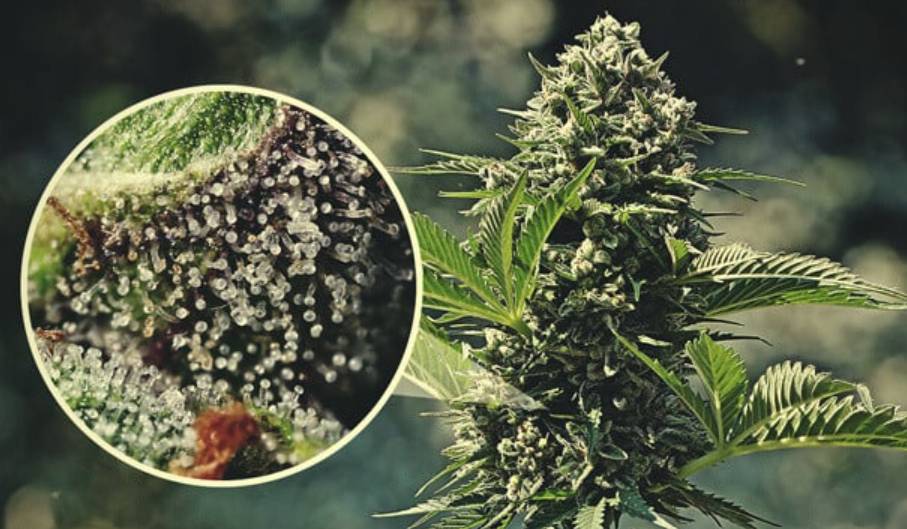
Let’s begin with the basics.
What are trichomes, and why do they important at all?
Trichome production on a cannabis plant leads to not only the tiny hair on your buds or a structure that usually occurs on your cannabis plant, but instead, they are almost everything that makes you love cannabis.
The trichome begins to develop in the maturing stage and have:
- Cannabinoids (THC, CBD, CBG, etc.)
- Flavonoids
- Terpenes
That means trichomes contain all the essential components of a usual weed bud that gives you the beautiful psychoactive and therapeutic effects, mouth-blessing taste, and an aroma to remember.
Therefore, when you harvest them, trichomes become an essential part of your cannabis plants to look upon.
If your trichomes remain underripe or overripe, you will most likely miss the utmost potential of your weed buds.
Most investments (money, time, and hard work) may fail.
When you want to harvest cannabis plants, you must check whether the trichomes are perfectly ripe.
Why Is Harvesting At Right Time Important?
Do you want the utmost potency from your weed buds?
And do you want to get the most delicious weed flavors?
If yes, you must harvest your cannabis plants at the perfect time. It is when trichomes ripen, and you can get the most out of your weed buds.
Otherwise, you need to compromise with the quality.
Further, trichomes have a lifespan. Depending upon the plant’s growth pattern when you start harvesting, your trichomes may be in either of these situations:
- Underripe
- Ripe
- Overripe
If you harvest your cannabis plants too early, you may face an underripe trichome situation. On the contrary, harvesting too late leads to over-ripeness of weed buds.
Also, there is a small window when your buds are perfectly ripe; it is when you should harvest your cannabis plants. At this time, you can get the most out of your weed buds.
It is why you should know why harvesting at the right time is so much important.
Weed Buds Ripening Process
Now as you understand why harvesting at the right time is important, it becomes essential that you should know about the ripening of cannabis buds.
Putting marijuana plants into the darkness phase, the growth pattern of your plant changes.
The usual growth rate, around five centimeters per day, slows down, indicating the vegetative growth period.
If you are growing a Sativa plant, you may observe the double size of the plant before it stops growth, while Indica plants tend to grow up to 25% bigger than before under a flowering light regime.
However, hybrid plants have a varying growth pattern between these two extremes.
Under this growth stage, male and female plants differentiate and become dimorphic.
Female marijuana plants grow short as compared to male plants. For example, male plants may have new shoots and tower above the female plants.
During the ripening, the male flower sacks and contains abundant pollen for pollinating the female plants.
As marijuana is wind-pollinated, the pollen from male plants is more likely to drift with the wind and fall into the female.
In the first week, female plants will start growing with thick stems and shorter nodes between the leaves.
Also, the number of fingers on the new leaves reduces, and plants no longer form leaves on the alternate sides of the stem.
It is the time when female weed plants start forming beautiful pistils. You can observe a hair-like structure on the plants. It is the place where the buds will eventually grow.
After this process, the flower growth will occur during further weeks of growth, joining the first stigmas. It is the time when the plants will spend most of their energy on the development of cannabis flowers.
Also, the color of the cannabis flowers may look like sunset or sunrise, which can vary from white to pink or red.
In further weeks, many stigmas begin forming along the stem on the top of the plant branches. The plant regularly produces new flowers as long as it remains unfertilized.
As the weed buds start maturing, you will observe the first signs of the swelling of calyxes. If the male fertilizes, the female pollen sacs release the plant’s seeds in the swollen calyx.
Therefore, the swollen calyx is one of the symptoms of trichome ripeness and may begin around two weeks before maturation.
Further, stigma color may vary according to genetics, temperature, and climate.
Though still, many Indica and Sativa develop red color, which may change to purple if the roots are subjected to a cool environment.
Trichome Ripening Process
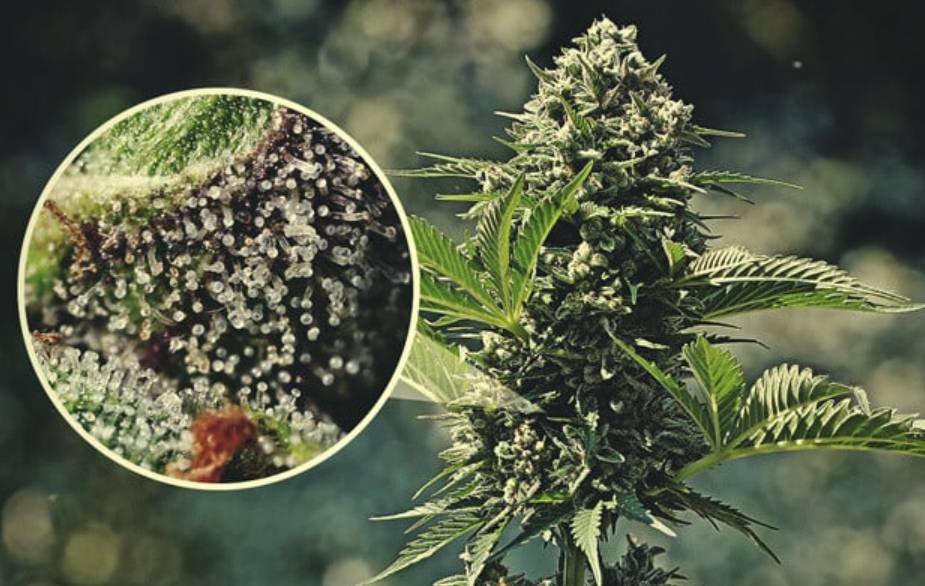
Once the buds are formed on a plant after proper plant growth and going through different stages, trichomes (the resin glands) will start creating on the plant’s leaves.
It may resemble a small hair-like appearance on the plants.
These resin glands are filled with THC, terpenes, and cannabinoids. As the resin glands grow, the cannabis flowers on the plant get covered entirely due to it.
This process or growth stage can last from 2 to 5 weeks, depending on the genetics, plant variety, and climate conditions.
The increased resin production will now be visible on the surface, indicating that the heavy flower growth period is ending.
When the new THC, flavonoids, and terpenes are produced in these resin glands, they become so packed with pure and potent medicine that the plant’s aroma intensifies this week.
Therefore, you need to check out for these symptoms in your cannabis plants.
However, when exposed to light, trichomes (the resin glands) are the most visually available feature of a marijuana plant.
The crystals like twinkling are another observation you can make in this final growth stage of trichomes.
How To Find If Cannabis Trichomes Are Perfectly Ripe?
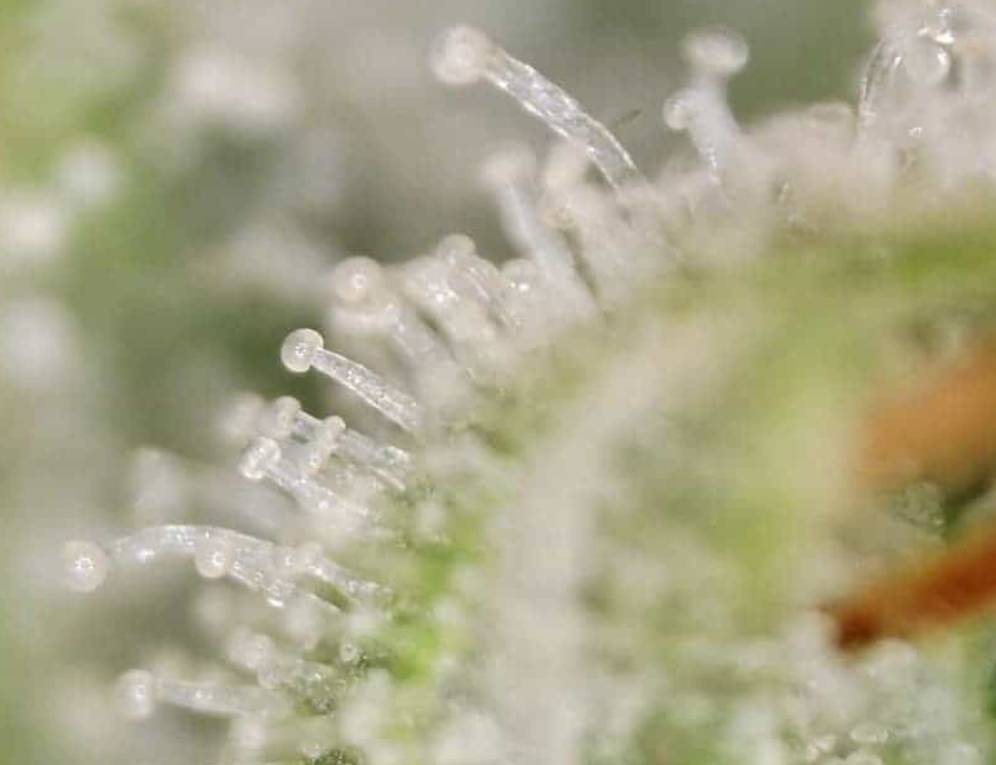
As of now, you already know the process of cannabis buds ripening and trichome ripening stages.
Therefore, it is now the perfect time to know how you can find out if your cannabis trichomes are ripened or not.
The best way to do so is by observing the trichomes through a feasible microscope or hand-held loupe. You need to invest in a good quality loupe for this process, which will be completely worth it.
It will provide you access to get perfectly baked weed buds.
Once you have the loupe or magnifying glass, you can follow these three steps to determine if your cannabis trichomes are perfectly ripe.
3 Steps To Know If Cannabis Trichomes Are Ripe Or Not With The Help Of Hand-Held Loupe
Before we can start, you need to have an essential tool for checking cannabis trichomes, which is a loupe in our case.
Just like growing tools for cannabis, a loupe is also a tool you need to buy and have.
Step 1: Know The Perfect Time
When you start sowing your seeds, you already know the flowering time of this variety of seeds. Right?
Also, the flowering time is already mentioned on the package, so you must know what the flowering time of the weed buds is.
Generally, most marijuana strains or weed seeds have a flowering time of around 8 to 9 weeks.
But you need to be sure of your plant type as the flowering time differs for various cannabis plants.
Once you know the flowering time of your weed plants, you need to wait accordingly before initiating the harvesting process.
Once you reach that time window of harvesting time after the flowering period ends, this is the time when you will need your loupe.
Step 2: Finding The Trichomes
Once you get your loupe in your hands, it is time to zoom in on the resin glands to see where the trichomes are.
You need to locate them before further inspection and observation.
To do so, you need to place a loupe on the cannabis buds and set your eye on the viewer. Remember, you don’t need to shake, so stay still and don’t shake marijuana flowers.
Now focus the loupe on the trichomes until you don’t get a clear picture of them.
Trichomes structures are like spherical glands that rest on top of a stalk. Also, if it is week seven or beyond of flowering, you can easily observe thousands of trichomes on the buds.
Now you have located the trichomes, so the observation part comes in.
Step 3: Know If Trichomes Are Ripened Or Not
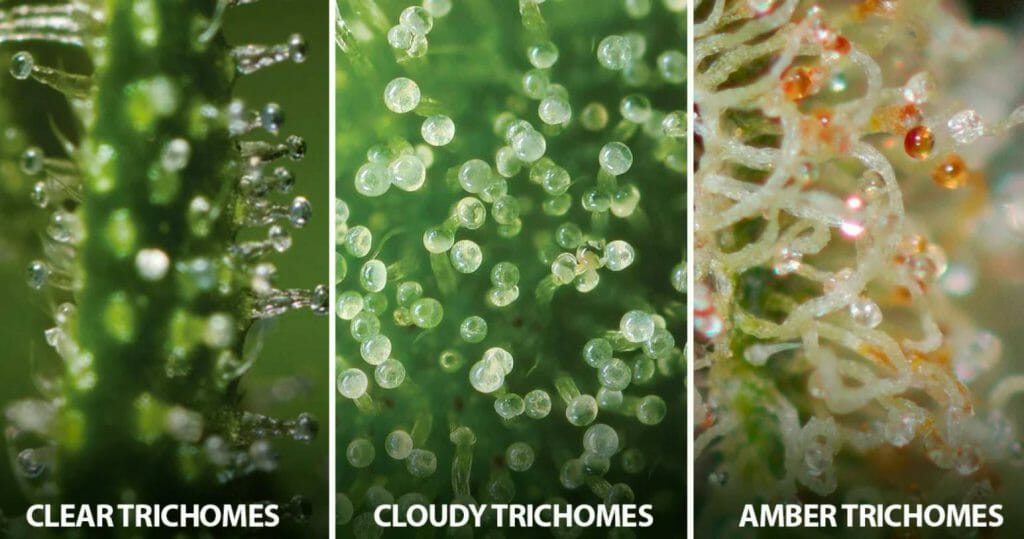
This last step is to know if your cannabis trichomes are ripe or not.
So the observations that you have to make are related to colors. And you need to make your observation for either of these three conditions:
- Clear Trichomes: Underripe
- Cloud Trichomes/Milky: Ripe
- Amber Trichomes: Overripe
So once you have observed the colors of your cannabis trichomes, you can quickly find if your cannabis trichomes are ripe or not by matching with the above three conditions.
If your marijuana trichomes are clear, you must check every 24 to 48 hours until most resin glands turn milky or cloudy.
However, until then, you need to check for the same and wait patiently.
Also, remember that you don’t need to overwait or leave your cannabis plants at such a stage. Otherwise, cannabis trichomes will overripe and show amber trichomes color.
And once the amber trichomes appear, it clearly indicates that you need to harvest marijuana plants as soon as possible because trichomes are now overripened.
So, with these three easy steps, you can quickly find if the cannabis trichomes are ripe or not after the flowering stage.
However, you must keep certain things in mind while doing these steps.
Points To Keep In Mind While Observing Through A Loupe
- Don’t move or shake the cannabis plants as you observe through the loupe. You need to stay still while making observations.
- Check every 24-48 hours once cannabis trichomes have turned milky or cloudy. So don’t wait for a longer time.
- Invest in a good quality loupe that can provide a clear picture of trichomes.
- The color of trichomes says all about their ripening conditions, so check your observations with the above color and stage of ripening before making any conclusion.
- If you are entirely new and cannot do the observation, you can take the help of an expert or a grower friend.
How To Know When To Harvest Your Weed Plants?
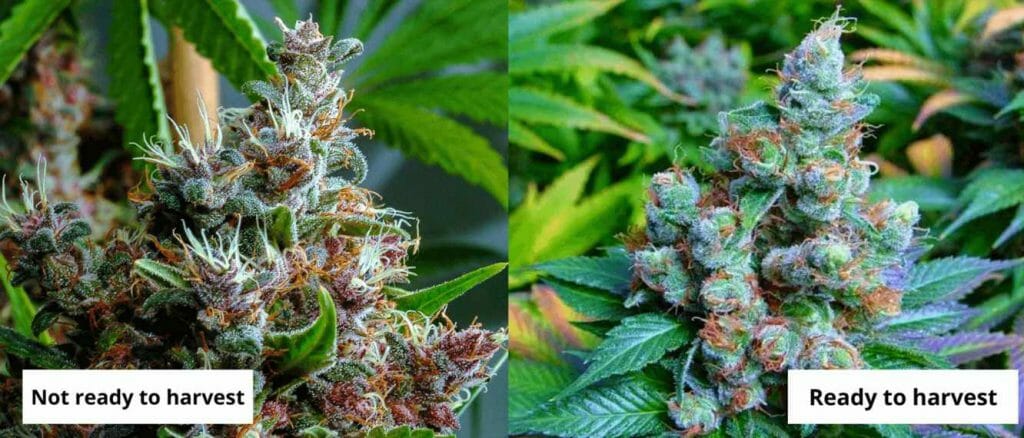
Some growers don’t have enough patience to wait for a few days to ensure the highest level of THC and other cannabinoids, and flavonoids and they harvest early.
It is what happens with most growers.
However, knowing when to harvest your weed plants can ensure you get the highest possible quality of weed.
And knowing the right time of harvesting is as important as growing them from seeds to a mature plants.
The harvest window of a cannabis plant is an approximation time frame that needs to be done so accurately that it can be near the perfect time.
Also, while calculating all of these, you need to understand the flowering time of your marijuana plant variety.
With the completion of flowering time, you can start observing your plant for resin glands and other features to know if they are getting ready for harvest.
According to the book “Marijuana Botany” by Robert C. Clarke, when marijuana buds have THC concentration at peak, the resin trichomes will have a translucent color appearance as the plant is still producing resin from the trichomes glands.
Along with it, terpenes (the aromatic molecules) production is also at its peak, which is still developing fragrant floral clusters.
Growers refer to harvest at this time because they want to have clear and cerebral psychoactive effects.
Also, if you are growing an Indica hybrid, then it is better to harvest your cannabis plants when the resin glands or trichomes have completely developed but not fully ripened.
Further, extending too much the flowering time of an Indica strain can severely impact its taste and effects; however, extending for only a few days should not be an issue.
On the contrary, if you are growing Sativa marijuana buds, you must wait for at least 30% of resin glands to turn amber before harvesting.
In the case of Sativa buds, extending the flowering time means you risk the taste and high.
Although it can also depend on the type or variety of strain you are growing.
The harvest time depends mostly upon marijuana strains, genetics, and phenotypes, so the harvesting time for different strains may vary accordingly.
That being said, if you are a grower and want to know the harvest time of your plants, then you need to put in some effort.
Start from knowing the flowering time to making observations with a loupe or microscope to learning and researching the various strains you are growing.
Otherwise, the other growers’ rules, methods, and observations can only tell you the general rules about marijuana plants that imply most of the available strain types.
And hence you can take the help of these tips or observations to know the right time for harvest for your cannabis plants.
If you are growing something different than usual, you need to get into it.
Take help from online growers, guides, and experts, and then make calculations and know the exact time frame when your plants will be happily ready to be “chopped out.”
Ripe Marijuana Bud Vs. Unripe Marijuana Bud
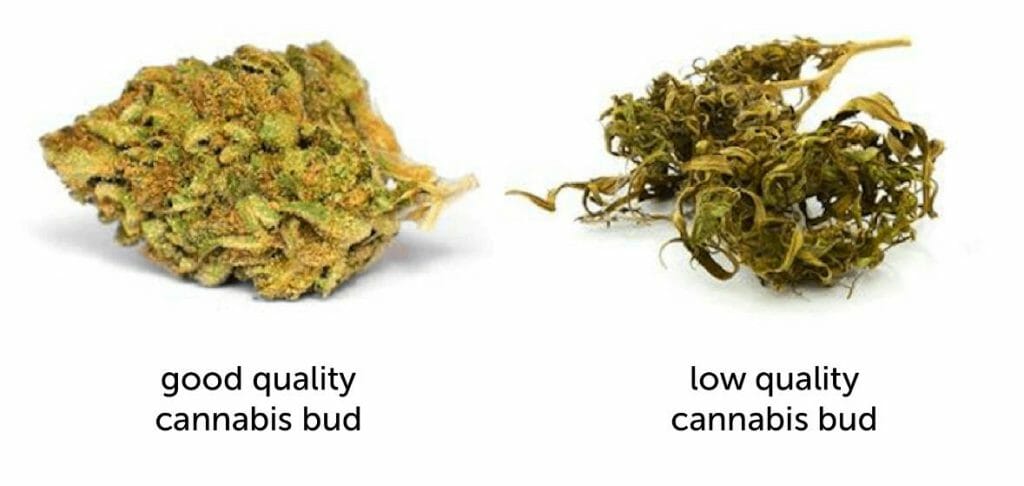
Until now, you must be aware that the ripening process of cannabis buds takes time, and it usually begins after the flowering time.
Depending upon the strain or plant type you are growing, marijuana flowering can take as little as six weeks to up to 12 weeks.
But in most cases, it stays around 8 to 10 weeks on average.
Therefore, if you want instant results from your marijuana garden, you must buy a fast strain with a flowering time of around 6 to 8 weeks.
On the other side, some Sativa strains can take up to 13 weeks to mature and prepare for harvest.
Once the flowering phase of your marijuana plant begins, you can notice the white hairs, also known as pistils, emerging from the small calyxes of the plant.
As your plant matures, the trichomes will be more prominent, and the stigmas will begin to brown.
Within time, the aroma around your plant will become more intense.
And once you observe your trichomes in fully erect mode with mature flowers and stigmas having a completely brown appearance.
The trichomes will change their color to milky white or amber color.
Now is the perfect time for harvesting your plants. Depending upon the plant variety you are growing, this period should last around 72 hours on average for the perfect harvesting window.
However, at this time, some growers wait a few more times to get more potent sedative effects, but keep in mind that there is a fine line between ripe and overripe.
So you need to be very careful as a grower.
Now let’s have a look at what benefits or features you get with ripe and unripe buds:
What Can You Expect from Ripe Buds:
- Ripe buds are the ideally harvested marijuana yield that every weed grower wants.
- Ripe cannabis buds have all the cannabinoids, flavonoids, and potency that can give you one of the best effects.
- Cannabis buds harvested at the right time are more likely to be delicious when puffed.
- Some growers also believe ripened marijuana buds have more therapeutic benefits than unripened marijuana buds.
- Ripened marijuana buds will give you a more intense high than unripened buds.
What Can You Expect from Unripened Buds:
- Unripened or under-ripe weed buds have less potency and weak sedative effects. So it is why you should avoid early harvesting.
- There is less likely to have therapeutic benefits with under-ripe marijuana buds.
- Under-ripe marijuana buds will not be that tasty as they lack flavonoids and other terpenes.
How To Trim Ripe Cannabis Buds?
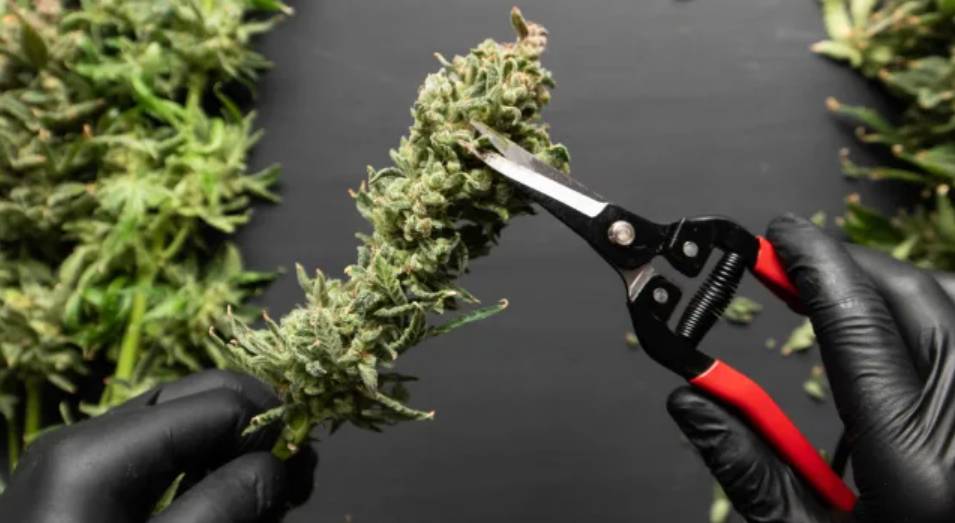
Once you know if your trichomes have ripened and you are ready for harvesting, your next move is to trim the ripened weed buds.
But how will you do that?
Worry not!
Here’s a brief and step-by-step guide on how you can trim ripened cannabis buds:
Step 0: Gather Accessories
Just like you invested in a good loupe for observing trichomes on your plants, similarly, before you can head for trimming your weed plants, you need to invest in some suitable accessories.
These accessories involve having:
- A good pair of trimming scissors
- Gloves (for protection and grip)
- Pruners (for big branches)
- A clear surface like a table
- Rubbing alcohol
- Tray/Bowl
- Non-sticky clothes
- Comfortable chair and space
- Entertainment
Step 1: Trim Your Marijuana Plant And Cut The Branches
Once you have made everything ready, you can trim your marijuana plant.
The first step is to cut the branches, dividing the plant into smaller pieces until you reach the plant’s main stem.
If you proceed with dry trimming, you must wait for 3 to 7 days until your weed buds get ‘dry.’
Once your buds are dried, you can proceed with the trimming process further.
However, if you are proceeding with wet trimming, head to step 2.
Step 2: Remove The Leaves And Cut The Buds Off The Branches
You need to eliminate fan leaves with little to no trichomes. After removing the fan leaves, you can cut the individual buds off the plant branches.
Step 3: Trimming Buds
Now that you have separated almost everything from the weed buds, it is time to trim them.
If the marijuana buds are too big, you can divide them into smaller parts according to your convenience.
Otherwise, you are good to go.
To proceed with bud trimming, you need to cut or trim the stem at the bottom of the bud as close as possible without breaking the actual bud.
Now remove the other leaves at the bottom of your weed buds, and you must trim off the excess plant matter covering your weed bud.
The ultimate purpose is to create an even surface around the marijuana buds. So, you need to trim following that.
Also, remove the red pistils down the foliage. Finally, after trimming the buds, you need to keep the trimmed buds separately in a tray or bowl that you have gathered before.
Last but not least, if your trimming is wet, you can put your wet trimmed buds on a drying rack for some days.
However, if your trimming is dry, you can proceed with the curing process.
To learn more about curing, read: How To Cure And Store Weed Buds For A Long Time?
Wet Vs. Dry Trim Of Cannabis Buds
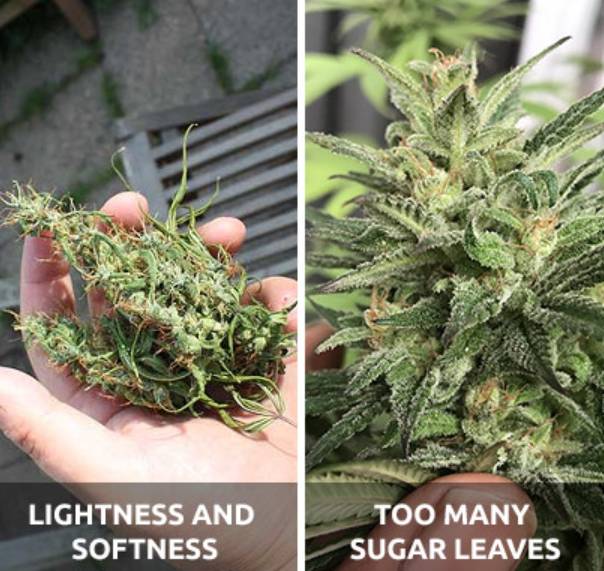
Once you harvest your weed buds and get ready to trim them off, there is always a question that pop-ups in a grower’s mind, and that is – whether to do the wet or dry trimming.
Both are convenient and excellent methods to proceed with when you start trimming.
However, most growers prefer wet trimming as it is quick and there is no waiting time.
On the other hand, some growers prefer dry trimming because they are more comfortable with it and have enough patience.
But let’s look closely at how wet and dry trimming differ and which will suit you once ready to harvest your marijuana plant.
Wet Trimming
It is one of the most favorite and preferred methods of trimming marijuana buds.
There are mainly two reasons for that:
- You don’t need to wait for days to move ahead in the process of curing weed buds
- It is done all at once
So, if you plan to wet trim, that means you can eliminate the trimming process all at once, unlike dry trimming.
In wet trimming, your buds get trimmed from branches, from the rest of the plant matter, and then you put your weed buds on a drying rack where they remain for some days to get ‘dry.’
Now let’s look at the advantages of wet trimming, making it the first option for growers.
Advantages Of Wet Trimming:
- Wet trimming is easy. Removing the fan leaves and sugar leaves is more accessible when the buds are wet.
- Wet trimming takes less time to trim.
- Cannabis buds, after wet trim, dry faster as weed buds with leaves will take more time to get rid of moisture due to extra plant matter attached to them.
- Due to faster drying after wet trimming, there is also less chance of issues with the mold forming between the stalk and the flower, a plus point for growers in humid climates.
- Wet trimming will take less space as you remove all the foliage off the buds before moving with the drying process.
Dry Trimming
Dry trimming, unlike wet trimming, involves keeping the plant upside down for several days until the weed dries out and gets rid of the moisture.
So, depending upon yield and regional climate conditions, you may need to wait for around seven days.
Once your weed buds get dry, you can pull the buds off the branches and trim them further.
Advantages Of Dry Trimming:
- With dry trimming, you are more likely to get better-quality weed buds, as retaining moisture while drying allows the weed buds to dry at the natural speed. It can help these buds to preserve potency and terpenes.
- Dry trimmer weed buds are likelier to provide a better smoking experience with smooth and pleasant smoke.
- It is also believed that the longer the buds take to dry, the more chlorophyll they lose, and less chlorophyll means the better flavor of the buds.
- In dry trimming, the buds are less sticky. Therefore there is not much mess, so it reduces your maintenance work.
- In dry trimming, you will have more control over the drying speed as the exterior foliage retains moisture. It will ensure that your buds don’t dry too fast.
So, what’s good dry or wet trimming?
It all depends on you how you are comfortable. With both ways, you will achieve the nearly identical quality of marijuana.
However, wet and dry trimming have their perks.
Most growers prefer wet trimming.
Still, the best part is that you will always be free to choose at your convenience and comfort.
What Happens When You Harvest Marijuana Flowers Too Late Or Too Soon?
They lose their potency and taste.
When you harvest your marijuana buds too soon or too late, they don’t have all potency, taste, and beneficial therapeutic properties that you could get by harvesting at the right time.
However, some growers also report that harvesting a little bit late when the trichomes are 60% amber color, weed buds will be more potent and produce stronger psychoactive effects.
But to make this type of harvest entirely successful, you need skills to observe and hit the perfect time to harvest your cannabis plants, which most newbie growers find challenging.
However, you can use a hand-held loupe or feasible microscope to monitor the trichomes continuously, and once you reach your perfect time, you can proceed with harvesting.
On the other hand, one more common scenario among growers is harvesting too early.
Whether it is exciting to get the weed buds quickly or to avoid the over-ripening stage, some growers harvest cannabis plants too early.
In that case, weed buds don’t reach their peak potential and may lack taste, aroma, and even psychoactive effects.
Harvesting early will not only leave you with under-ripe weed buds, but it will also make your smoking sessions bad.
Therefore, whether you harvest too early or too late, both types of harvests are wrong to get the most out of your weed buds.
The perfect time to harvest your marijuana plant is when they show cloudy or milky trichomes, which means they are ready to get harvested.
Best Cannabis Buds Ripening Techniques
Do you want to boost the ripening process of your marijuana plants?
Well, you can follow certain things that most professional and licensed cannabis growers do, increasing the chances of fastening the process of ripening weed buds.
So look at the factors that can give you a better gardening result overall.
LED Grow Lights
Professional growers believe that LED grow lights always produce better quality buds and contribute to fastening the ripening process of the buds.
Also, a good light means the buds will have a good quality of cannabinoids, flavonoids, and terpenes.
So, you must invest in an excellent quality LED grow light.
You can read our Best LED Grow Lights guide here.
However, if you are growing cannabis plants outdoors, you will not have the same control over the environmental factors as indoor growers.
But that does not mean outdoor plants don’t have any other optimization methods.
You can start by having the best outdoor cannabis seeds, and then you can choose and optimize the soil quality for maximum output during the harvest time.
Also, you can know and use nutrients during the most critical growth stages of your marijuana plants.
Additionally, suppose you live in a region with unpredictable weather. In that case, you can prepare yourself beforehand for the problems with your plants (such as mold, moisture level, harsh temperature, and pests).
These will eventually help you get a better yield overall.
Environmental Factors
Although indoor growers have the maximum control over the environmental conditions, take full advantage of it if you are growing weed plants indoors.
Optimize the environmental conditions and optimize it for fastening the ripening process, which you can do by keeping environmental conditions in near-to-ideal mode.
However, it is one of the ways to optimize the cannabis ripening process and minimize the chances of problems.
Forcing Cannabis Buds Ripening
Forcing the cannabis ripening process means forcing your cannabis plants into bloom by reducing the daily light hours to around 12 hours.
By doing so, your plants get fewer light hours and more darkness, resulting in forcefully reaching into bloom.
However, this technique is only implemented by indoor growers. Therefore, outdoor growers can’t have such control in all the regions.
Apart from all these things, you should never forget that you should always give your plant the natural time it takes for the best results.
Going for shortcuts or applying unfaithful methods can also negatively impact harvest.
Therefore, the best way is to let your cannabis plant take the natural time it wants for maturing.
However, using usual techniques to boost the growth stage (such as fertilizers and nutrient solutions) is always helpful, and you can focus on that.
FAQs About Cannabis Trichome Ripeness
What should trichomes look like when ready to harvest?
When trichomes mature, they appear milky and have a slightly yellowish tone, which means they are ready to harvest.
However, if the trichomes appear clear, they are under-ripened, and you need to wait some more time.
On the other hand, if the trichomes appear with amber-like color, that means the trichomes are over-ripened, and you need to harvest your cannabis plants immediately.
What happens if you wait too long to harvest?
Some grower report waiting longer for harvest may somewhat increase intoxication and sedative effects in the weed buds.
However, some also report that overextending the flowering stage before harvesting may degrade the THC content.
How long does it take to go from milky to amber trichomes?
Trichomes remain milky for about two weeks during the growth lifecycle of a cannabis plant, growers mainly harvest only this time, leading to a perfectly ripened marijuana yield.
However, waiting longer than this may lead to the amber-like appearance of trichomes, indicating that they are overripe and you should harvest them immediately.
How long do trichomes take to ripen?
When trichomes look clear and transparent, they enter the early ripening stage. It may usually occur after 56 days of flowering.
And after this stage, trichomes become ready when they appear milky. However, after this over-ripening stage comes into effect, which may degrade the quality of buds.
The best solution is to keep an eye on the trichomes of your buds, which will eventually help you to know if they have perfectly ready for the harvest.
Should I wait for trichomes to turn amber?
Some growers report that cloudy trichomes give uplifting and stimulating clear-headed high while waiting for trichomes to turn slightly amber, resulting in even heavier and more intense effects.
Also, some believe that waiting for at least 60% of the trichomes to turn amber can give you powerful effects when smoked buds.
But the better option will be to harvest on the right stage, which is trichomes turning into cloudy or milky appearance.
How can I make my buds ripen faster?
It is tough to suggest shortcuts to a process that nature dictates. However, there might be some wild suggestions online that may claim to fasten up the ripening process of cannabis buds.
But you should always focus on ethical or natural ways to let your plants thrive and produce yield as they do naturally.
Providing them with excellent climate conditions and taking care of your plants are always the best tips you can follow to boost your garden’s growth and ripening process.
Can light intensity affect cannabis ripening time?
There is no claim yet that light can affect the ripening time; however, providing the quality of light and time can indeed affect the cannabis yield in the end.
Therefore, to increase the yield and overall better results, expert and professional marijuana growers prefer growing with LED grow lights.
Conclusion
Now you finally know why some buds are delicious and have the utmost potency while some don’t. The apparent difference is their harvest time and trichome ripeness of buds.
Once you know how to harvest at a perfect time and avoid the overripe trichomes, you will win the game of harvesting.
I hope this guide will help you know if your cannabis buds are ripe and if you can harvest them at the right time.
However, after harvesting, you need to focus on curing and storing the weed buds, which is the most crucial part of keeping weed buds for a long duration.
You can read our detailed guide on How To Cure Weed Buds?

